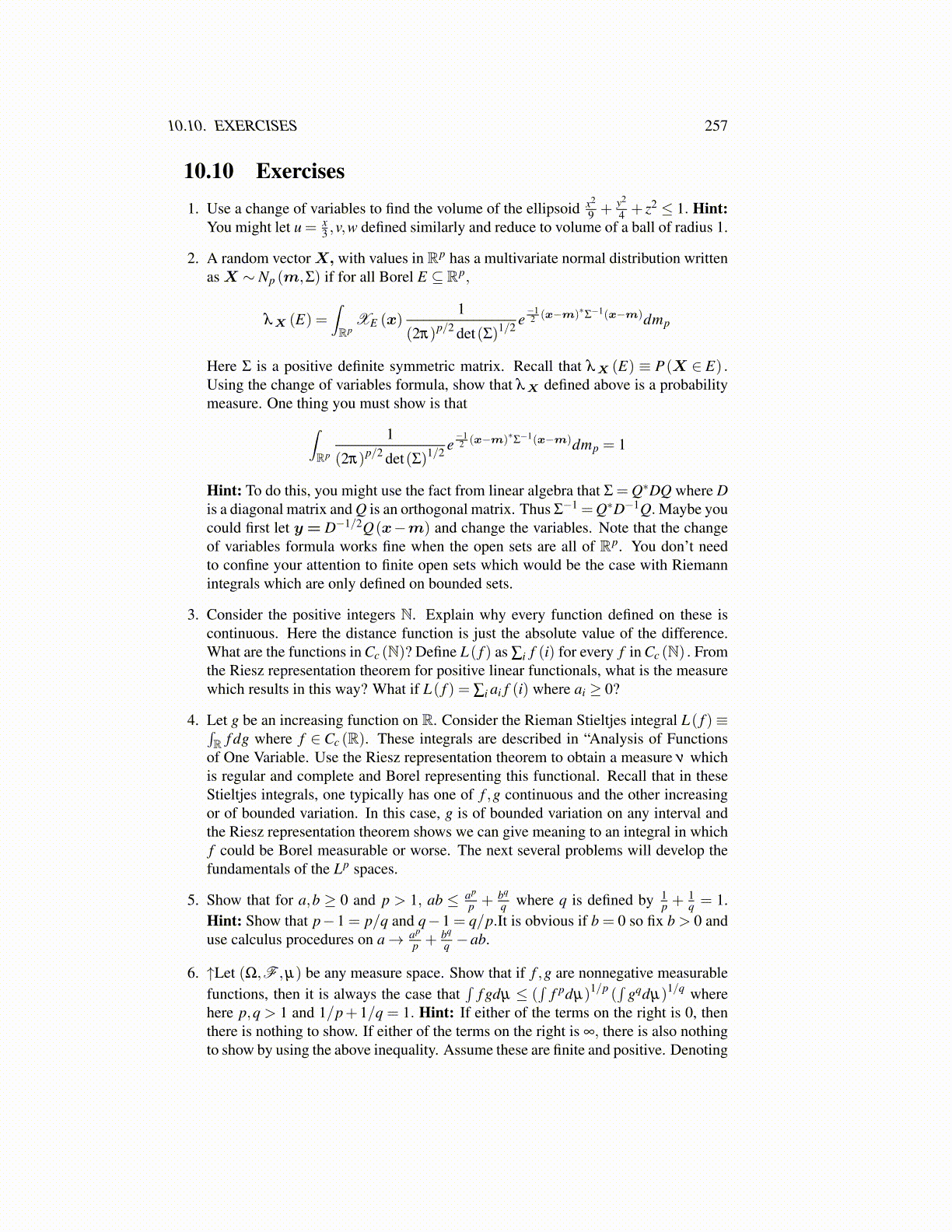
10.10. EXERCISES 257
10.10 Exercises1. Use a change of variables to find the volume of the ellipsoid x2
9 + y2
4 + z2 ≤ 1. Hint:You might let u = x
3 ,v,w defined similarly and reduce to volume of a ball of radius 1.
2. A random vector X, with values in Rp has a multivariate normal distribution writtenas X ∼ Np (m,Σ) if for all Borel E ⊆ Rp,
λX (E) =∫Rp
XE (x)1
(2π)p/2 det(Σ)1/2 e−12 (x−m)∗Σ−1(x−m)dmp
Here Σ is a positive definite symmetric matrix. Recall that λX (E) ≡ P(X ∈ E) .Using the change of variables formula, show that λX defined above is a probabilitymeasure. One thing you must show is that∫
Rp
1
(2π)p/2 det(Σ)1/2 e−12 (x−m)∗Σ−1(x−m)dmp = 1
Hint: To do this, you might use the fact from linear algebra that Σ = Q∗DQ where Dis a diagonal matrix and Q is an orthogonal matrix. Thus Σ−1 =Q∗D−1Q. Maybe youcould first let y = D−1/2Q(x−m) and change the variables. Note that the changeof variables formula works fine when the open sets are all of Rp. You don’t needto confine your attention to finite open sets which would be the case with Riemannintegrals which are only defined on bounded sets.
3. Consider the positive integers N. Explain why every function defined on these iscontinuous. Here the distance function is just the absolute value of the difference.What are the functions in Cc (N)? Define L( f ) as ∑i f (i) for every f in Cc (N) . Fromthe Riesz representation theorem for positive linear functionals, what is the measurewhich results in this way? What if L( f ) = ∑i ai f (i) where ai ≥ 0?
4. Let g be an increasing function on R. Consider the Rieman Stieltjes integral L( f )≡∫R f dg where f ∈ Cc (R). These integrals are described in “Analysis of Functions
of One Variable. Use the Riesz representation theorem to obtain a measure ν whichis regular and complete and Borel representing this functional. Recall that in theseStieltjes integrals, one typically has one of f ,g continuous and the other increasingor of bounded variation. In this case, g is of bounded variation on any interval andthe Riesz representation theorem shows we can give meaning to an integral in whichf could be Borel measurable or worse. The next several problems will develop thefundamentals of the Lp spaces.
5. Show that for a,b ≥ 0 and p > 1, ab ≤ ap
p + bq
q where q is defined by 1p +
1q = 1.
Hint: Show that p−1 = p/q and q−1 = q/p.It is obvious if b = 0 so fix b > 0 anduse calculus procedures on a→ ap
p + bq
q −ab.
6. ↑Let (Ω,F ,µ) be any measure space. Show that if f ,g are nonnegative measurablefunctions, then it is always the case that
∫f gdµ ≤ (
∫f pdµ)1/p (
∫gqdµ)1/q where
here p,q > 1 and 1/p+1/q = 1. Hint: If either of the terms on the right is 0, thenthere is nothing to show. If either of the terms on the right is ∞, there is also nothingto show by using the above inequality. Assume these are finite and positive. Denoting